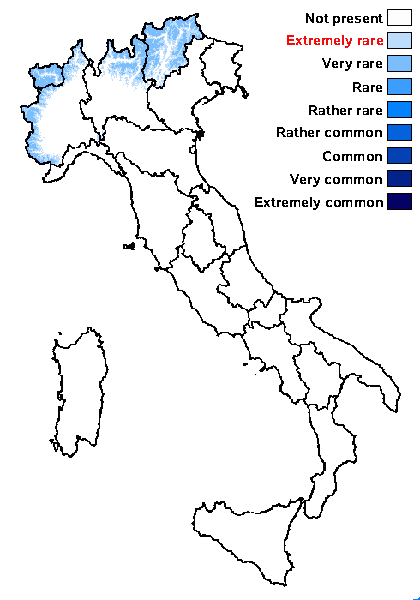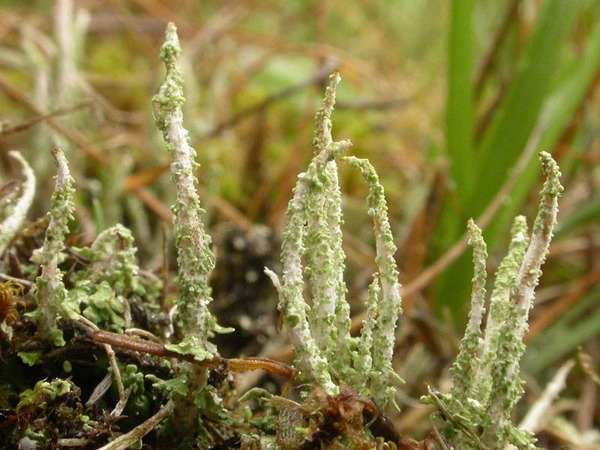Cladonia decorticata (Flörke) Spreng.
Syst. Veget., 4, 1: 273, 1827. Basionym: Capitularia decorticata Flörke - Beitr. Naturk., 2: 297, 1810.
Synonyms:
Distribution: N - TAA (Nascimbene & al. 2007b, 2022, Nimis & al. 2015), Lomb (Rivellini & Valcuvia 1996, Gheza 2019b, Gheza & al. 2022), Piem (Isocrono & al. 2004), VA (Piervittori & Isocrono 1997, 1999).
Description: Primary thallus squamulose, persistent or evanescent, the squamules 1.5-3(-4) mm long 1-2 mm broad, irregularly divided, usually becoming concave, glaucescent or olive-green on upper side, white beneath, often darkening towards the attachment point. Podetia frequent, bacilliform, hollow inside with a very narrow, <10 μm wide central canal, pale grey to whitish grey, not melanotic at base, 4-10(-15) mm tall, 0.5-1 mm thick, usually cupless, sometimes with a few apical branches and open axils, with a verruculose cortex, the warts dispersed, tending to become subsquamulose-phyllidiate. Apothecia very rare, dark brown, convex, terminal. Asci 8-spored, clavate, thickened at apex, with a K/I+ blue tholus and a K/I+ strongly blue outer gelatinous sheath, Cladonia-type. Ascospores 1-celled, hyaline, ellipsoid. Pycnidia rare, mostly on primary squamules, constricted at base, with a colourless jelly. Conidia hyaline, curved. Photobiont chlorococcoid. Spot tests: K-, C-, KC-, P-, UV+ ice-blue. Chemistry: perlatolic acid and three unknown compounds.Note: an arctic-alpine to boreal-montane, circumpolar species found on mineral, more rarely on organic soil and rotting wood in open habitats, restricted to siliceous areas in the Alps.
Growth form: Fruticose
Substrata: lignum, soil, terricolous mosses, and plant debris
Photobiont: green algae other than Trentepohlia
Reproductive strategy: mainly asexual, by soredia, or soredia-like structures (e.g. blastidia)
Commonnes-rarity: (info)
Alpine belt: very rare
Subalpine belt: very rare
Oromediterranean belt: absent
Montane belt: extremely rare
Submediterranean belt: absent
Padanian area: absent
Humid submediterranean belt: absent
Humid mediterranean belt: absent
Dry mediterranean belt: absent

Predictive model
Herbarium samples
Growth form: Fruticose
Substrata: lignum, soil, terricolous mosses, and plant debris
Photobiont: green algae other than Trentepohlia
Reproductive strategy: mainly asexual, by soredia, or soredia-like structures (e.g. blastidia)
Commonnes-rarity: (info)
Alpine belt: very rare
Subalpine belt: very rare
Oromediterranean belt: absent
Montane belt: extremely rare
Submediterranean belt: absent
Padanian area: absent
Humid submediterranean belt: absent
Humid mediterranean belt: absent
Dry mediterranean belt: absent

Predictive model
| Herbarium samples |
 INDEX FUNGORUM
INDEX FUNGORUM
 GBIF
GBIF
 DOLICHENS
DOLICHENS




